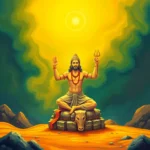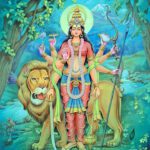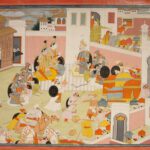In the vast and intricate world of Hindu mythology, the figure of Urvashi holds a prominent place. She is not just a celestial nymph or an apsara; her stories weave through various ancient texts, revealing much about the cultural values and artistic expressions of the time. Urvashi is often depicted as the epitome of beauty and grace, captivating the hearts of gods and mortals alike. Her tales encompass themes of love, sacrifice, and the complex interplay between the divine and human realms. Through her narratives, we can explore the deeper meanings of desire and the consequences that come with it.
The Origins of Urvashi
Urvashi’s origins can be traced back to the Vedas, the oldest sacred texts of Hinduism. According to these ancient scriptures, she is one of the most beautiful celestial nymphs created by the god Brahma. The Vedas describe her as a radiant being, possessing an unparalleled charm that could enchant any deity or human. Her beauty is often compared to that of the finest jewels, symbolizing purity and divinity. As one of the apsaras, Urvashi’s primary role was to entertain the gods in the heavenly realm, showcasing the artistic skills of dance and music.
 Upanishads
UpanishadsUrvashi’s story begins with her association with the King Pururavas, a mortal king who fell deeply in love with her. Their love story is a central theme in various texts, including the Mahabharata and the Harivamsa. The relationship between Urvashi and Pururavas illustrates the tension between the divine and the mortal, highlighting the challenges that arise when these two worlds collide. As an apsara, Urvashi is bound by the laws of the heavens, and her interactions with Pururavas lead to both joyous and tragic consequences.
The Love Story of Urvashi and Pururavas
The love story of Urvashi and Pururavas is one of the most enchanting tales in Hindu mythology. Their romance is marked by passion and longing, as Pururavas is captivated by Urvashi’s beauty the moment he lays eyes on her. In a dramatic turn of events, Urvashi, enchanted by Pururavas’ bravery and charm, reciprocates his feelings. Their love blossoms in the lush landscapes of ancient India, filled with poetic imagery and emotional depth. However, their relationship is not without its challenges, as Urvashi is bound by the laws of the heavens.
 Uma
UmaOne of the key elements of their story is the curse that affects their relationship. The gods, observing their love, become concerned about the potential disruption to the cosmic order. They impose a curse that requires Urvashi to return to the heavens, leaving Pururavas heartbroken. This separation creates a profound sense of longing and sorrow, which resonates throughout the narrative. Urvashi’s struggle to balance her duties as an apsara with her love for Pururavas adds layers of complexity to her character.
The Themes of Desire and Sacrifice
The love story of Urvashi and Pururavas is rich with themes of desire and sacrifice. Their relationship exemplifies the powerful force of love, but it also highlights the sacrifices that must be made in its pursuit. Urvashi, despite her deep affection for Pururavas, must ultimately choose her responsibilities as a celestial being over her personal desires. This conflict serves as a poignant reminder of the often painful choices individuals must face when navigating the complexities of love.
- Desire: The intense longing between Urvashi and Pururavas illustrates the depth of human emotion.
- Sacrifice: Urvashi’s decision to leave Pururavas underscores the sacrifices made in the name of duty.
- Longing: The story encapsulates the essence of yearning, a universal theme in love stories.
As their love story unfolds, we witness the profound impact of desire on both characters. Pururavas’ journey is marked by his relentless pursuit of Urvashi, reflecting the human tendency to chase after what is unattainable. His willingness to sacrifice everything for love resonates with readers, making his character relatable. Meanwhile, Urvashi’s internal struggle showcases the complexity of being torn between love and duty, a theme that is prevalent in many mythological tales.
 Ugrasena
UgrasenaUrvashi in Different Texts
Urvashi appears in various ancient texts, each offering a unique perspective on her character and story. In the Mahabharata, she is portrayed as a figure of immense beauty and charm, captivating the hearts of heroes and gods alike. Her interactions with the legendary warrior Arjuna further illustrate her role as a divine being who influences the course of mortal lives. In this epic, Urvashi’s beauty is not just a superficial trait; it symbolizes the allure of the divine and the consequences of desire.
Another significant text featuring Urvashi is the Harivamsa, which expands on her relationship with Pururavas. This narrative delves deeper into their love story, exploring the emotional turmoil and longing that characterize their bond. The Harivamsa presents Urvashi as a multi-dimensional character, emphasizing her strength and resilience in the face of adversity. Through her trials, readers gain insight into the complexities of love and the sacrifices that often accompany it.
Symbolism and Cultural Significance
Urvashi’s character is rich with symbolism, representing not only beauty but also the duality of love and duty. In Hindu culture, she embodies the idea of the feminine divine, showcasing the strength and vulnerability inherent in women. Her stories often reflect the societal expectations placed on women, particularly in relation to love and marriage. Urvashi’s choices resonate with the struggles many women face, making her a timeless figure in mythology.
- Beauty: Urvashi’s beauty symbolizes the divine feminine and the allure of the celestial.
- Love: Her love story represents the complexities of human emotions and relationships.
- Duty: Urvashi’s sacrifices highlight the conflict between personal desires and societal expectations.
Furthermore, Urvashi’s tales have inspired countless works of art, literature, and dance throughout history. Her character has been depicted in various forms, from classical dance performances to modern interpretations in films and literature. This enduring legacy speaks to the cultural significance of Urvashi, as she continues to captivate audiences with her enchanting stories.
The Role of Urvashi in Classical Dance
Urvashi’s influence extends beyond literature and mythology into the realm of classical dance. In various Indian dance forms, such as Bharatanatyam and Kathak, dancers often portray Urvashi to showcase her beauty, grace, and emotional depth. The portrayal of Urvashi in dance is not merely a representation of physical beauty; it also embodies the emotional turmoil and longing associated with her character. Dancers use intricate movements and expressions to convey the complexity of her emotions, allowing audiences to connect with her story on a deeper level.
Through dance, Urvashi’s character becomes a vessel for exploring themes of love, desire, and sacrifice. The movements and expressions of the dancer often reflect Urvashi’s inner struggles, inviting the audience to empathize with her plight. The beauty of classical dance lies in its ability to tell stories without words, allowing the audience to feel the emotions conveyed through the dancer’s artistry.
Urvashi in Modern Interpretations
In contemporary culture, Urvashi continues to inspire artists, writers, and filmmakers. Her character has been reimagined in various forms, adapting her story to resonate with modern audiences. In literature, authors have drawn upon Urvashi’s tale to explore themes of love and duty in today’s society. This reinterpretation allows readers to connect with her character in a new light, highlighting the timeless nature of her story.
- Literature: Modern authors use Urvashi’s story to explore contemporary themes of love and sacrifice.
- Film: Cinematic adaptations bring Urvashi’s tale to life, showcasing her beauty and emotional depth.
- Art: Visual artists draw inspiration from Urvashi, creating works that celebrate her allure and complexity.
In film, directors have depicted Urvashi’s character in various narratives, blending traditional elements with modern storytelling techniques. These adaptations often emphasize her strength and resilience, showcasing her as a symbol of empowerment. By reinterpreting Urvashi’s story, modern creators continue to keep her legacy alive, ensuring that her tale resonates with new generations.
The Legacy of Urvashi
The legacy of Urvashi is profound, as she remains a beloved figure in Hindu mythology. Her story transcends time, offering valuable lessons about love, sacrifice, and the complexities of human emotions. Through her character, we explore the delicate balance between desire and duty, a theme that resonates across cultures and eras. Urvashi’s tales continue to inspire artists, dancers, and writers, ensuring that her essence endures in the hearts and minds of people worldwide.
Urvashi’s significance in Hindu mythology goes beyond her beauty. She embodies the struggles and triumphs of love, serving as a reminder of the complexities of human relationships. Her stories encourage reflection on the choices we make in the name of love and the sacrifices we are willing to endure. As we delve into the world of Urvashi, we uncover not just a mythical figure, but a timeless symbol of the human experience.
